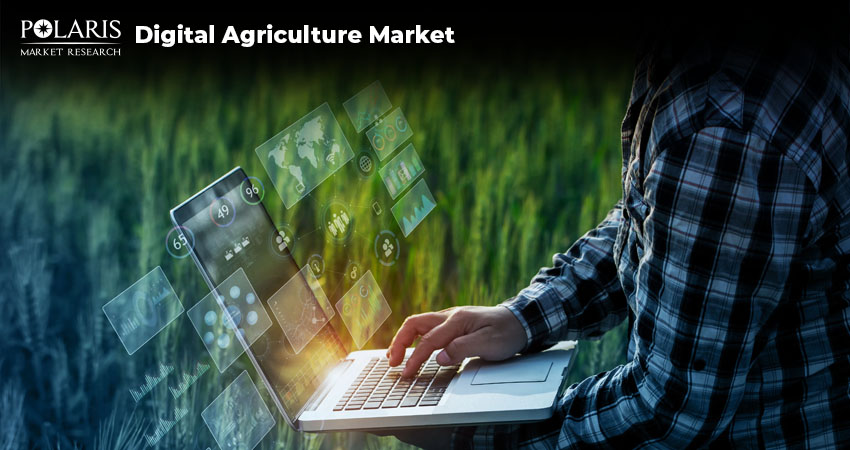Digital Agriculture: A New Era of Precision and Productivity

Agriculture is one of the oldest industries of humanity. And it’s undergoing a radical transformation in the modern world. In the face of rising global food demands, climate change, resource scarcity, and labor shortages, the agriculture sector is rapidly embracing technology to reshape how food is grown, managed, and distributed. This is the era of digital agriculture, which combines information technology and farming practices to revolutionize the way the world feeds itself.
In this blog post, we take you to the fascinating realm of the digital agriculture market, explaining you its evolution and key technologies involved. In addition, we shed light on the benefits and applications of this rapidly growing aspect of the agriculture industry. Let’s dive in!
What is Digital Agriculture?
Also referred to as smart farming or e-agriculture, digital agriculture involves the integration of digital tools, technologies, and data-driven approaches. It aims to enhance the productivity, sustainability, and efficiency of agricultural operations by leveraging advanced technologies such as satellite imagery, IoT devices, AI algorithms, and blockchain. These technologies provide farmers with real-time insights, predictive analytics, and automated decision-making support. Unlike conventional farming, which relies heavily on manual observation and experience-based decision-making, digital agriculture leverages data at every level.
Key Stats of Digital Agriculture Market
The market for digital agriculture is poised to witness sustained growth in the coming years. The digital agriculture market size was valued at USD 24.16 billion in 2024. It is projected to grow to USD 64.68 billion by 2034, exhibiting a CAGR of 10.4% during 2025–2034.
The Evolution of Agriculture
Agriculture has undergone a profound transformation over the centuries, evolving from manual practices to highly sophisticated, technology-driven systems. In its earliest form, what we now refer to as Agriculture 1.0, agriculture was purely analog. At that time, it was characterized by manual labor, simple tools, and reliance on natural cycles and indigenous knowledge.
The next major leap came with Agriculture 2.0, marked by the mechanization era during the Industrial Revolution. The introduction of plows, tractors, and mechanical harvesters resulted in a significant reduction in human effort and improvements in farming efficiency. This was followed by Agriculture 3.0, or the Green Revolution. Agriculture 3.0 brought with it scientific advancements such as high-yield seed varieties, synthetic fertilizers, pesticides, and modern irrigation techniques. Along with feeding a global population, it introduced environmental and sustainability challenges.
Today, the world is in the midst of Agriculture 4.0, a digital revolution that’s transforming agriculture through advanced technologies. Unlike past revolutions focused on physical labor or chemical inputs. Agriculture 4.0 is driven by information. The digital agriculture market is transforming every aspect of agriculture, from soil monitoring and crop planning to harvesting and market delivery.
Key Technologies Driving Digital Agriculture
The transformation of agriculture into a data-driven, precision-based industry is being fueled by a powerful suite of technologies. These include:
Internet of Things (IoT)
IoT technology is playing a pivotal role in connecting various farm elements, such as plants, soil, water systems, and machinery, into a unified network. IoT devices such as soil sensors, pH monitors, and livestock trackers are embedded across the farm for continuous collection of real-time data. This information assists farmers in informed decision-making, allowing for more efficient use of resources, better crop health, and reduced environmental impact.
Drones and Satellite Imagery
Drone and satellite imagery capture high-resolution images and multispectral data that help farmers monitor crop health, detect pest infestations, and assess land topography. Drones have the capability to scan large fields in a relatively short time and create maps that can reveal variations in plant and soil health conditions. This allows for the precision application of fertilizers and pesticides, thereby lowering input costs and minimizing environmental damage.
Artificial Intelligence (AI) and Machine Learning (ML)
AI and ML are bringing intelligent automation and predictive capabilities to the agriculture sector. These systems analyze massive amounts of data to offer actionable insights to farmers. For instance, AI can forecast the best planting and harvesting methods based on expected rainfall or temperature changes. It can also enable timely treatment and prevention of large-scale losses by identifying crop diseases early through image recognition.
Blockchain Technology
The use of blockchain helps bring transparency, traceability, and trust to agriculture supply chains. Traditionally, the agricultural supply chain involves multiple intermediaries, offering little visibility into how food is grown, stored, or transported. The use of blockchain allows every transaction and event to be recorded in a decentralized digital ledger that can’t be altered, creating an immutable record of every product. This is particularly useful for organic or fair-trade products, where certification and authenticity play a key role.
Benefits of Digital Agriculture
There are several benefits associated with the digital agriculture market. Here are some of them:
Enhanced Productivity: Precision farming techniques reduce input waste and enhance crop yields. Farmers can tailor their actions based on real-time data, resulting in higher resource utilization and improved output.
Sustainable Farming: With climate change posing a threat to arable land, digital agriculture promotes eco-friendly practices. Tools such as variable-rate technology (VRT) help apply fertilizers and pesticides only where needed, which lowers environmental impact.
Risk Mitigation: Digital farming tools allow farmers to respond quickly to adverse conditions such as floods, droughts, and pest outbreaks. Predictive models allow for better planning and reduce uncertainty.
Cost Efficiency: Automation helps reduce the dependency on manual labor and allows for the optimized use of water, fertilizers, and pesticides. This leads to reduced operational costs and improved profit margins.
Enhanced Market Access: Digital platforms bridge the gap between farmers and markets. Through e-commerce channels and blockchain-based traceability, producers gain better access to domestic and global markets with increased pricing transparency.
Conclusion
In conclusion, the digital agriculture market is about fundamentally rethinking how we grow food to make it more intelligent, sustainable, and inclusive. As the world faces the dual pressure of feeding a growing population and preserving the planet, embracing digital tools in agriculture is a necessity.

